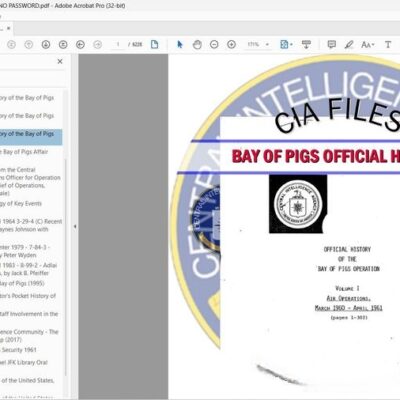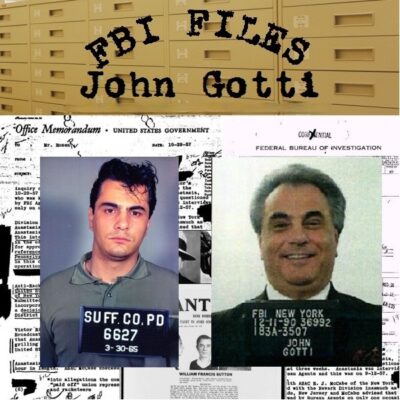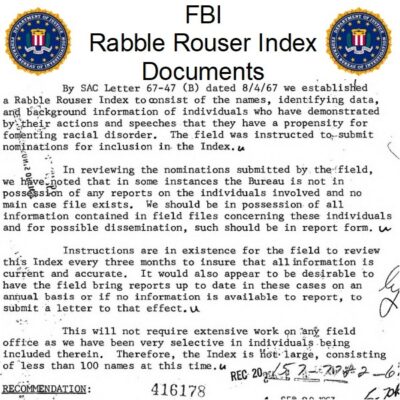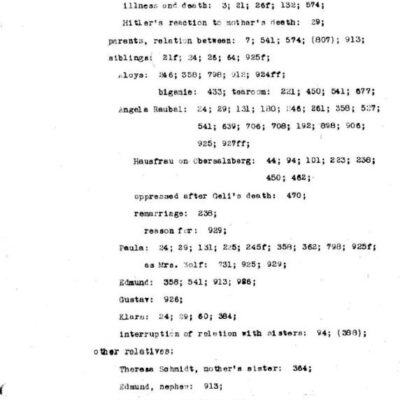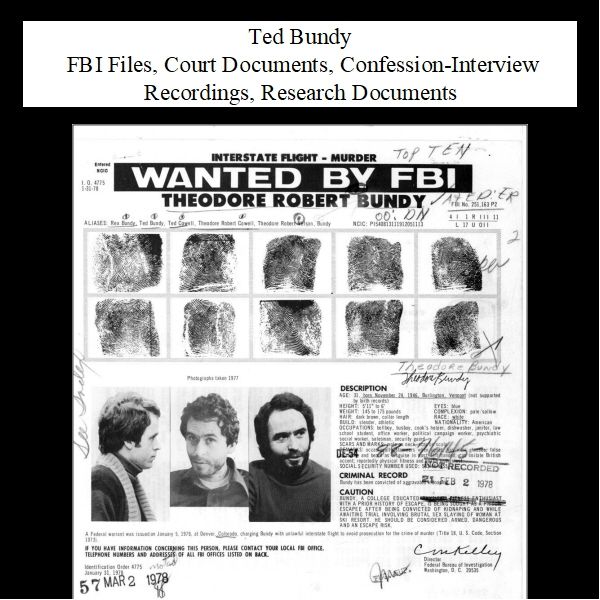
Ted Bundy FBI Files, Court Documents, Confession-Interview Recordings, Research Documents
$19.50
Description
Ted Bundy: Timeline, Cast, and Legacy
1974
- Early 1974: Ted Bundy’s killing spree is underway in Washington State. Young female college students begin disappearing. Witnesses report a Volkswagen Beetle and a man on crutches or with an arm in a sling.
- Summer 1974: Bundy moves to Salt Lake City, Utah, where murders continue there and in Colorado.
1975
- August 1975: Police arrest Ted Bundy for the first time in Utah after pulling him over in his Volkswagen. They find suspicious items, including handcuffs, rope, and a ski mask, which investigators later link to missing women.
1976
- February 1976: Ted Bundy is found guilty of kidnapping and assaulting a Utah teenager who had managed to escape from him. He is sentenced to prison for up to 15 years.
1977
- June 7, 1977: While in the Aspen, Colorado courthouse for a hearing dealing with a first-degree murder charge (for killing a vacationing nursing student) after being convicted of kidnapping Carol Daronch in Salt Lake City, Bundy escapes by jumping from a window.
- A few days after June 7, 1977: Bundy is captured in Aspen.
- December 31, 1977: Bundy escapes from Garfield County Jail by losing 30 pounds and slithering through a crawl space. He murders at least three victims while free.
1978
- January 1978: Bundy makes his way to Tallahassee, Florida, where he rents an apartment near Florida State University under the name Chris Hagen.
- Saturday, January 14, 1978: Bundy breaks into Florida State University’s Chi Omega sorority house, bludgeoning and strangling two women to death.
- February 9, 1978: Bundy kidnaps and mutilates 12-year-old Kimberly Leach, killing her.
1979
- June 1979: Ted Bundy goes on trial for the Chi Omega sorority house murders, acting as his own lawyer. Prosecutors offer him a plea bargain of a 75-year sentence, which he declines. He is subsequently convicted and sentenced to death.
1983
- July 12, 1983: Testimony regarding Bundy is given at the “Serial Murders – Hearing Before the Senate Subcommittee on Juvenile Justice of the Committee on The Judiciary, United States Senate.”
1989
- January 22, 1989: Ted Bundy is interviewed by Salt Lake County Sheriff’s Detective Dennis Couch at Florida State Prison, 36 hours before his execution. This interview lasts 1 hour and 30 minutes.
- January 1989 (undated, before execution): Former King County, Washington detective Bob Keppel conducts an interview with Bundy at Florida State Prison. Portions of this interview (21 minutes from 4 hours of recordings) are later used for training at the FBI Academy. During this interview, Bundy brags and laughs about murdering 11 young women in Washington.
- January 24, 1989: Ted Bundy is executed.
- March 1989: The BUNDY Multi-Agency Investigative Team conference takes place at the FBI Academy in Quantico, Virginia, under the auspices of the FBI’s NCAVC Violent Criminal Apprehension Program. This meeting assesses and shares intelligence based on Bundy’s final revelations before his execution.
1992
- 1992: The “FBI Ted Bundy Multiagency Investigative Team Report” (a 50-page report) is published, stemming from the 1989 conference.
1995
- September 14, 1995: Testimony regarding Bundy is given at the “Serial Killers and Child Abduction – Hearing Before the House Subcommittee on Crime of The Committee on The Judiciary.”
1999
- 1999: A Freedom of Information Act request leads to the release of 314 pages of FBI files related to Ted Bundy.
2005
- August 29 – September 2, 2005: The “Serial Murder Symposium” takes place in San Antonio, Texas.
- 2005: The FBI Behavioral Analysis Unit-2 National Center for the Analysis of Violent Crime produces the 71-page book “FBI Report Serial Murder Multi-Disciplinary Perspectives for Investigators,” which is distributed at the 2005 symposium.
- 2005: FBI Director William S. Sessions writes about Bundy, noting his infamous status and how his multi-jurisdictional crimes complicated investigations.
2011
- 2011: The FBI Behavioral Analysis Unit-4 National Center for the Analysis of Violent Crime produces the 79-page book “FBI Report Serial Murder Pathways for Investigations.”
2017
- 2017: A new release of FBI files on Ted Bundy provides 339 unique pages.
Cast of Characters
- Theodore Robert “Ted” Bundy: (Deceased) The central figure of the sources, described as “perhaps, society’s most infamous and notorious serial killer.” He committed crimes across multiple jurisdictions, including Washington, Utah, Colorado, and Florida, involving kidnapping, assault, bludgeoning, strangulation, and mutilation of young women and girls. He was known for two prison escapes and acted as his own lawyer in his 1979 murder trial. He confessed to multiple homicides before his execution.
- William S. Sessions: (Active in 2005) FBI Director in 2005, who commented on Bundy’s notoriety and the complexity his multi-jurisdictional crimes posed for investigations.
- Carol Daronch: (Victim) A Utah teenager whom Ted Bundy kidnapped and assaulted. She managed to escape, and Bundy was convicted of her kidnapping in February 1976.
- Kimberly Leach: (Victim) A 12-year-old girl whom Ted Bundy kidnapped and killed on February 9, 1978, in Florida. She was also mutilated.
- Bob Keppel: (Law Enforcement/Investigator) A former King County, Washington detective who interviewed Ted Bundy at Florida State Prison in 1989, prior to Bundy’s execution. Portions of his interview were later used for FBI Academy training.
- Dr. Ken Muscatel: (Criminal Psychologist) A criminal psychologist who commented on Ted Bundy’s recorded interview responses, describing them as “Pure performance. Pure manipulation. Utterly narcissistic and there was no emotion expressed there, no feelings.”
- Dennis Couch: (Law Enforcement/Investigator) A Salt Lake County Sheriff’s Detective who conducted a 1 hour and 30-minute interview with Ted Bundy at Florida State Prison on January 22, 1989, 36 hours before Bundy’s execution.
Ted Bundy FBI Files, Court Documents, Confession-Interview Recordings, Research Documents
This collection contains 2,025 pages of material and 1 hour and 50 minutes of audio. All computer recognizable text in the collection can be searched. One search can cover all documents in this collection.
FBI Director William S. Sessions wrote in 2005 about Bundy, “Theodore Robert Bundy has become, perhaps, society’s most infamous and notorious serial killer. By committing his crimes in many different jurisdictions, he wittingly or unwittingly complicated the investigative efforts to identify, locate, and prosecute him.”
Bundy’s killing spree was underway in 1974. In the state of Washington, young female college students began disappearing. witnesses reported a Volkswagen Beetle and a man on crutches or with an arm in a sling. In the summer of 1974 Bundy moved to Salt Lake City where the murders continued there and in Colorado. In August 1975, police arrested Bundy for the first time after pulling him over in his Volkswagen and finding suspicious items—including handcuffs, rope, and a ski mask investigators later linked to missing women. In February of the following year, he was found guilty of kidnapping and assaulting a Utah teenager who had managed to escape from him. He was sentenced to prison for up to 15 years.
On June 7, 1977, after Bundy was convicted of kidnaping Carol Daronch in Salt Lake City, he was in the Aspen Colorado courthouse for a hearing dealing with a first-degree murder charge for killing a vacationing nursing student. Bundy was allowed to move about the courthouse freely, he jumped from a window and escaped. He was captured in Aspen a few days later.
On December 31st, 1977, Bundy escaped from Garfield County Jail by losing 30 pounds and slithering through a crawl space. Bundy murdered at least three victims while free. He made his way to Tallahassee, Florida where he rented an apartment near Florida State University under the name Chris Hagen. On Saturday, Jan. 14, 1978, Bundy broke into Florida State University’s Chi Omega sorority house and bludgeoned and strangled to death two women. On February 9, 1978, Bundy killed 12-year-old Kimberly Leach, who he kidnapped and then mutilated.
In June of 1979, he went on trial for the sorority house murders acting as his own lawyer. Prosecutors feared he may have won over some of the jurors, so they offered Bundy a plea bargain where he would receive a 75-year sentence for the murders. Bundy declined the offer and was convicted and sentenced to death. Bundy was executed on January 24th, 1989.
Ted Robert Bundy FBI Files
339 pages of files copied from FBI Headquarters in Washington D.C., covering serial killer Theodore Robert Bundy. This collection contains two sets of FBI files one from a 1999 Freedom of Information Act request containing 314 pages and a 2017 release containing 339 pages. Files contain at least 339 unique pages. The first release has newspaper articles and approximately 90 pages of narrative material. The files give an overview of the FBI’s hunt for Bundy while free after his two jail escapes.
FBI Ted Bundy Multiagency Investigative Team Report 1992
A 50-page report published in 1992.
Abstract: “In March 1989, under the auspices of the FBI’s NCAVC Violent Criminal Apprehension Program investigators involved in BUNDY’s final revelations and other knowledgeable law enforcement officials attended the BUNDY Multi-Agency Investigative Team conference at the FBI Academy in Quantico, Virginia. The purpose of this meeting was to assess and share intelligence among the participants, inasmuch as the BUNDY interviews at the prison preceding his execution were specific as to individual crimes. Following the Quantico meeting, specialists from, the FBI’s Visual Investigative Analysis Unit consulted with investigators throughout the country in an attempt to formulate a singular data base reflecting BUNDY’s documented whereabouts over the years. They hoped that such information, coupled with information derived by investigation and BUNDY’s own revelations, might lead to the solution of additional unsolved murders.
The NCAVC and BUNDY conference members have responded to numerous inquiries from investigators who are attempting to determine BUNDY’s culpability in unsolved matters. It is the purpose of this report to share, within the law enforcement community, information relative to BUNDY’s crimes, furnish insight into his activities, and provide the most accurate timeline possible for establishing his whereabouts during any known period.”
Information provided in the report includes:
Homicide Admissions
Modus Operand!
Conclusion
Timeline
Criminal Information Numbers
Fingerprint Classification
Alias Information
Alias Dates of Birth
Alias Social Security Numbers Used
Residences Where Lived
Driver’s License Numbers
Occupations
Items Used or Taken During Crimes
Vehicles
Homicides to Which Bundy Confessed
Pictures of Bundy’s VW
Items in Bundy’s VW
Photos of Bundy
Bundy Lineup Photo Pensacola
FBI Report Serial Murder Multi-Disciplinary Perspectives for Investigators (2005)
A 71-page book produced in 2005 by the FBI Behavioral Analysis Unit-2 National Center for the Analysis of Violent Crime. It covers serial murders and killers in general and was distributed at the 2005 Serial Murder Symposium U.S. Department of Justice Federal Bureau of Investigation in San Antonio, Texas August 29 – September 2, 2005.
FBI Report Serial Murder Pathways for Investigations (2011)
A 79-page book produced in 2011 by the FBI Behavioral Analysis Unit-4 National Center for the Analysis of Violent Crime. It covers serial murders and killers in general.
Abstract: This monograph represents five years of empirical research gathered by experts at the FBI’s National Center for the Analysis of Violent Crime Our hope is that it will give our law enforcement partners the resources they need to better understand the motivations and behaviors behind these crimes, to discover the necessary correlations between potential suspects and cases, and to more expeditiously identify, arrest, and convict serial killers.
Court Documents
1,000 pages of documents from 7 appellate court cases heard in Florida and Utah.
Congressional Hearings Reports and Transcripts
Testimony was given at the following hearings with some information regarding Bundy.
Serial Murders – Hearing Before the Senate Subcommittee on Juvenile Justice of the Committee on The Judiciary, United States Senate July 12, 1983
Serial Killers and Child Abduction – Hearing Before the House Subcommittee on Crime of The Committee on The Judiciary September 14, 1995
Audio Interviews/Confessions
FBI Copy of Audio Interview/Confession Tapes
21 minutes of audio drawn from 4 hours of recordings of a 1989 interview of Bundy by former King County, Washington detective Bob Keppel, used in training at the FBI Academy in Quantico, Virginia.
During the interview at Florida State Prison Bundy brags and laughs about murdering 11 young women in the state of Washington. Criminal psychologist Dr. Ken Muscatel has commented about Bundy recorded responses. “Pure performance. Pure manipulation. Utterly narcissistic and there was no emotion expressed there, no feelings,” Dr. Muscatel said.
Ted Bundy Interview by Salt Lake County Sheriff’s Detective Dennis Couch 1-22-1989
1 hour and 30-minute interview of Ted Bundy at Florida State Prison by Dennis Couch, conducted on January 22nd,1989, 36 hours before Bundy’s execution.
